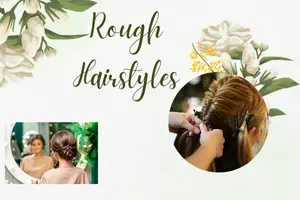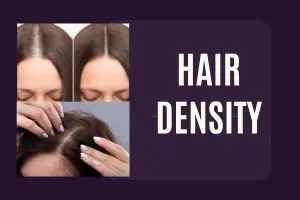Black Hair Type Chart- Understanding Your Hair for Optimal Care and Styling
Published: 7 Dec 2024
Black hair is a tapestry of rich textures and patterns, each strand telling its own story. Whether adorned with soft curls or tight coils, understanding your unique hair type is the first step toward embracing its natural beauty. The Black Hair Type Chart, developed by Andre Walker, categorizes hair into types 3 and 4, each with specific subcategories. This guide delves into these classifications, offering insights on identification, care, and styling tailored to your hair’s distinct needs.
What is the Black Hair Type Chart
The Black Hair Type Chart is a classification system that organizes textured hair care based on curl pattern, thickness, and strand shape. It primarily focuses on two categories: Type 3 (Curly) and Type 4 (Coily) hair, each with its subcategories that define the tightness and shape of the curls.
- Type 3: Curly Hair (3A, 3B, 3C)
- Type 4: Coily/Kinky Hair (4A, 4B, 4C)
Each subtype within these categories has unique characteristics and care requirements.
Type 3: Curly Hair
In the curly hair chronicles, Type 3 hair is celebrated for its defined ringlets that range from loose loops to tight corkscrews. This hair type, while stunning, is often more prone to dryness and frizz due to its spiral shape, which makes it harder for natural oils to travel down the strands.
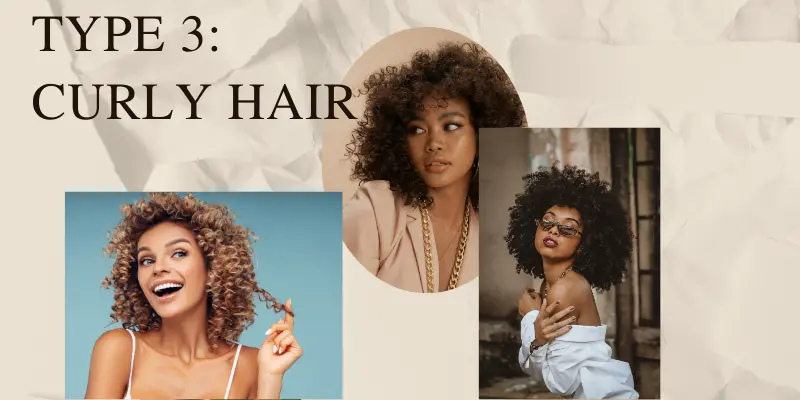
Proper moisture, curl-enhancing products, and gentle handling are key to keeping Type 3 curls bouncy, healthy, and well-defined.
Type 3A: Loose Curls
- Description: Large, loose curls with a definite “S” pattern.
- Characteristics: Shiny, soft texture, but prone to frizz.
- Care Tips:
- Use lightweight curl-enhancing products.
- Avoid heavy creams that can weigh down curls.
- Deep condition weekly to maintain moisture.
Type 3B: Medium Curls
- Description: Tighter curls with a springy ringlet shape.
- Characteristics: Voluminous and coarse, often with a combination of textures.
- Care Tips:
- Incorporate moisturizing shampoos and conditioners.
- Use leave-in conditioners and styling creams to define curls.
- Seal in moisture with natural oils like argan or jojoba.
Type 3C: Tight Curls
- Description: Tightly packed curls, similar in circumference to a pencil or straw.
- Characteristics: Dense and coarse, with a high volume.
- Care Tips:
- Apply curl creams and gels for definition.
- Limit heat styling to prevent damage.
- Regularly moisturize and incorporate protein treatments as needed. Woman.
Type 4: Coily/Kinky Hair
Type 4 hair, also known as coily or kinky hair, is tightly curled with a zigzag or spring-like pattern. It is the most delicate type of hair and is prone to shrinkage, dryness, and breakage if not cared for properly.
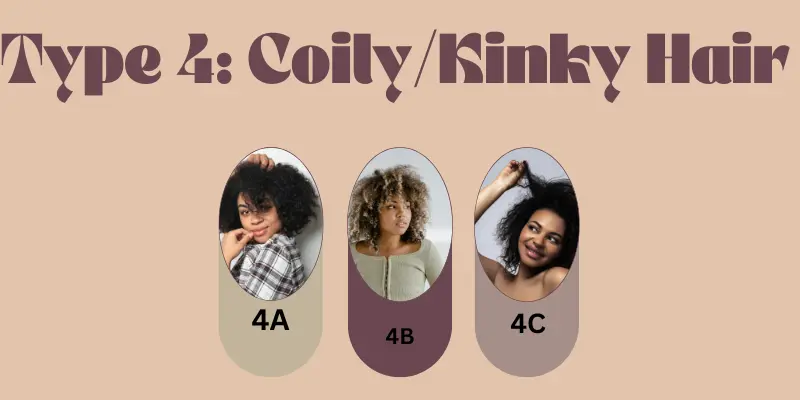
Deep hydration, protective styles, and minimal manipulation are essential for maintaining the strength, elasticity, and beauty of coily hair.
Type 4A: Soft Coils
- Description: Tightly coiled “S” pattern, similar in size to a crochet needle.
- Characteristics: Soft texture with visible curl definition.
- Care Tips:
- Use creamy leave-in conditioners and butters.
- Implement the LOC (Liquid, Oil, Cream) or LCO (Liquid, Cream, Oil) method for moisture retention.
- Minimize manipulation to prevent breakage.
Type 4B: Z-Pattern Coils
- Description: Sharp angles forming a “Z” pattern with less defined curls.
- Characteristics: Fluffy appearance with significant shrinkage.
- Care Tips:
- Apply heavy creams or butters for moisture.
- Use stretching techniques like braiding or twisting to reduce shrinkage.
- Opt for protective styles to maintain hair health.
Type 4C: Tight Coils with Minimal Definition
- Description: Very tight, densely packed coils with minimal visible curl pattern.
- Characteristics: Prone to shrinkage (up to 75%) and breakage.
- Care Tips:
- Use heavy styling products containing shea butter or castor oil.
- Limit styling to reduce friction and breakage.
- Incorporate protective styles like braids or twists.
Determining Your Black Hair Type
Identifying your hair type involves assessing several factors:
- Curl Pattern: Observe the shape and size of your curls.
- Shrinkage: Note how much your hair shortens when it dries.
- Texture: Feel the thickness of individual strands- fine, medium, or coarse.
- Porosity: Determine how well your hair retains moisture.
Understanding these aspects will help tailor your hair care routine effectively.
General Hair Care Tips for All Black Hair Types
- Moisturize Regularly: Use leave-in conditioners, oils, and creams to maintain hydration.
- Protective Styling: Incorporate styles like braids or twists to minimize manipulation.
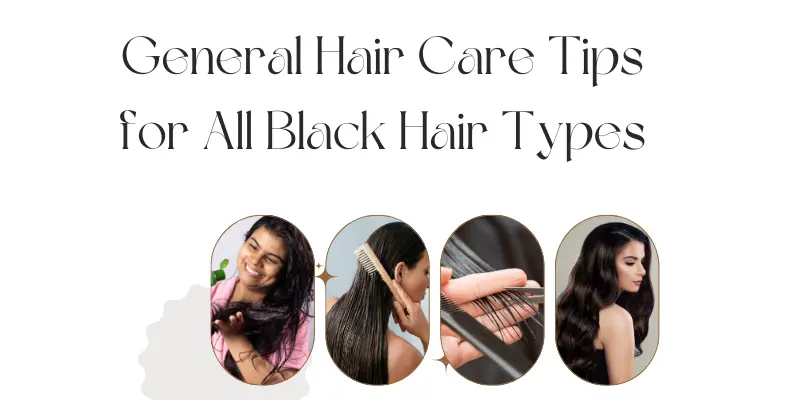
- Limit Heat Usage: Reduce the use of heat styling tools to prevent damage.
- Regular Trimming: Trim ends every 6-8 weeks to prevent split ends.
- Sleep Protection: Use silk or satin pillowcases to reduce friction and retain moisture.
Personal Experience: Embracing My 4B Hair Journey
Growing up, I struggled to manage my 4B hair, often using chemical relaxers to achieve a straighter look. It wasn’t until college that I began embracing my natural texture. Through trial and error, I discovered the importance of moisture and protective styling. Incorporating the LOC method and regular deep conditioning transformed my hair’s health, leading to stronger, more defined coils.
Conclusion
Understanding the Black Hair Type Chart is essential for effective care and styling. By identifying whether your hair falls under Type 3 or Type 4, along with its specific subcategory, you can tailor your routine to its unique needs. Embrace your natural texture, and with the right care, let your hair truly flourish with the Black Hair Type Chart as your guide.
FAQS:
The Black Hair Type Chart is a classification system that helps identify different curl and coil patterns in textured hair. It ranges from 3A, which has loose, defined curls, to 4C, which has tightly coiled strands with little visible curl definition. The chart also considers hair thickness, texture, and shrinkage. Knowing your type helps in choosing the right products and styling methods.
You can determine your hair type by observing your curl pattern, strand thickness, and shrinkage level. For example, looser curls that resemble spirals may fall into the 3 range, while tighter coils belong to type 4. Porosity also plays a role—whether your hair easily absorbs moisture or resists it. Examining different parts of your scalp is helpful, as many people have more than one type.
3C hair features tight, springy curls about the size of a pencil or straw, with more defined ringlets. 4A hair, on the other hand, forms soft coils in a distinct “S” pattern and tends to shrink more when dry. While both are curly, 4A hair is denser and requires more moisture. Styling techniques may differ slightly, but both benefit from hydrating products.
Yes, it’s common to have a combination of textures across your head. For example, you may notice looser curls near the front (like 3C) and tighter coils at the crown or nape (like 4B or 4C). This variation is completely natural and can even change as your hair grows. Because of this, your routine may need to include multiple techniques or products.
Type 4C hair typically requires the highest level of moisture and hydration. Its very tight coil pattern makes it prone to dryness since natural oils from the scalp have a harder time traveling down the strand. This leads to breakage and shrinkage if not properly cared for. Regular use of rich creams, oils, and protective styles helps maintain healthy 4C hair.
Moisturizing frequency depends on your hair type and lifestyle, but daily or every other day is recommended for most natural hair. Type 4 textures, especially 4B and 4C, tend to need moisture the most often. Using a leave-in conditioner, water-based spray, or sealing with oil can keep hair soft and flexible. Consistency is the key to preventing dryness and breakage.
Thicker products like shea butter, mango butter, castor oil, and heavy creams are excellent for 4C hair. Leave-in conditioners and moisturizing hair milks help soften coils and make them more manageable. Because 4C hair is prone to dryness, layering products with the LOC method (Liquid, Oil, Cream) is especially effective. Avoid drying products with sulfates or alcohol.
Shrinkage is a natural sign of healthy curls, but you can manage it with stretching methods. Techniques like braiding, twisting, banding, or African threading elongate the hair while keeping curls intact. Heat-free stretching is best to avoid damage, but occasional blow-drying on low heat can also help. Protective styles can reduce shrinkage while maintaining moisture.
Yes, detangling curly or coily hair while it’s dry can lead to breakage, split ends, and unnecessary frizz. The safest way is to detangle when your hair is damp or fully coated with conditioner. This adds slip, reduces friction, and makes it easier to manage knots. Wide-tooth combs or your fingers work best for minimizing damage.
Protective styles like braids, twists, bantu knots, wigs, and updos help reduce breakage and retain moisture. They minimize daily manipulation, giving your hair a chance to grow and recover. Styles should not be too tight, as this can cause tension and thinning along the edges. Pairing protective styles with regular moisturizing ensures long-lasting hair health.

- Be Respectful
- Stay Relevant
- Stay Positive
- True Feedback
- Encourage Discussion
- Avoid Spamming
- No Fake News
- Don't Copy-Paste
- No Personal Attacks

- Be Respectful
- Stay Relevant
- Stay Positive
- True Feedback
- Encourage Discussion
- Avoid Spamming
- No Fake News
- Don't Copy-Paste
- No Personal Attacks
